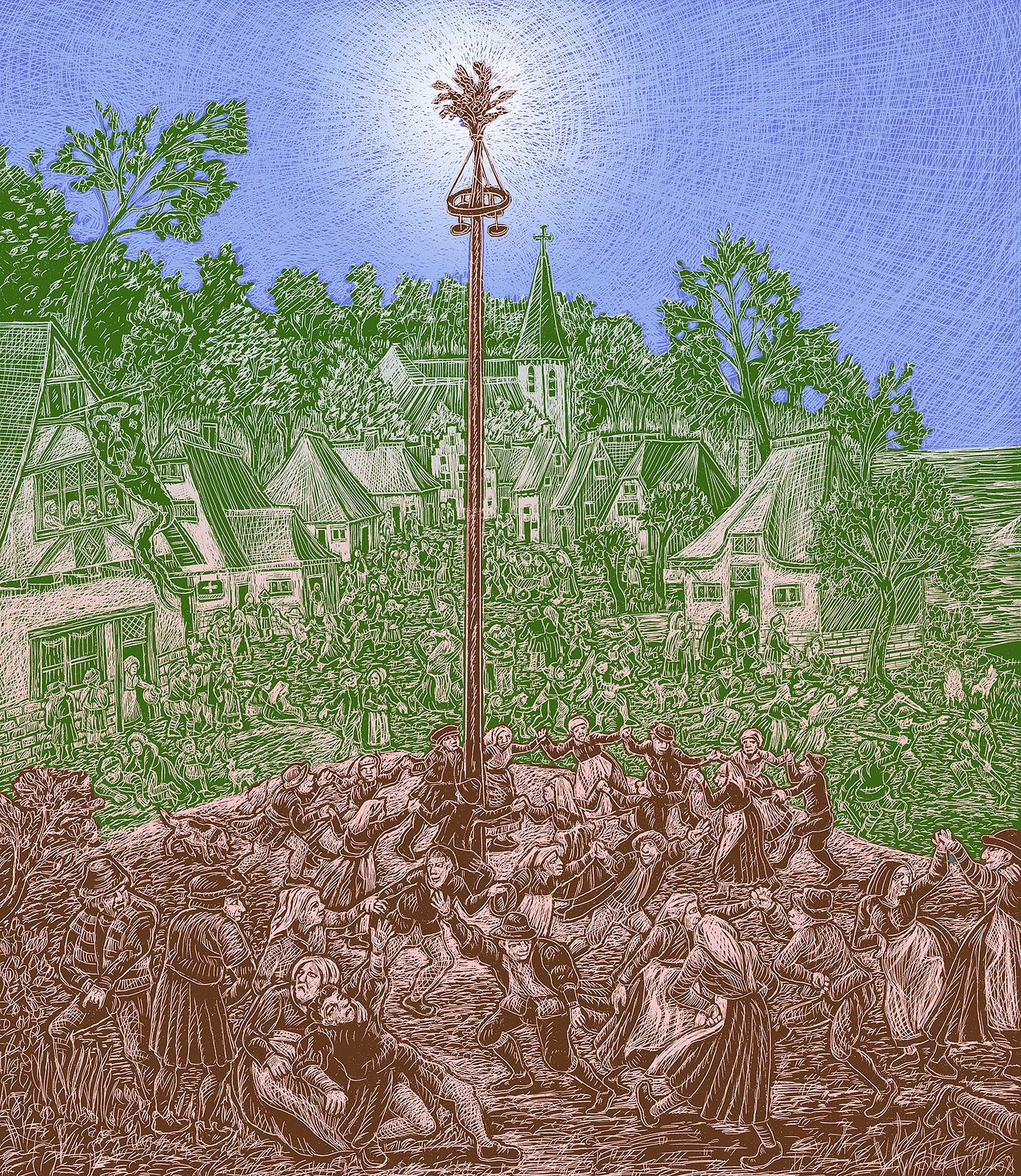Illustrations by Jos Sance and text by Fred Glass
These illustrations for the award-winning thirty-minute documentary video We Mean to Make Things Over (Fred Glass, 2022) were created by Jos Sances using scratchboard technique. This takes place on a black board incised to expose the white clay underneath, much like the way a block print is created. The images were scanned and colored within Photoshop.
1. During the Middle Ages, May Day was contested terrain in Europe, with pagan and Christian elements contending and incorporated into Catholic Saints Days. This drawing pays homage to Pieter Brueghel's "Dance Around the May Pole".
2. By the nineteenth century rising working class movements for a shorter workday adapted May Day from its origins as a celebration of spring renewal of the earth to a demand to renew society.
3. Life away from work in the nineteenth century for urban workers was focused around the need for sleep. The unhealthy results of a ten or twelve hour day and six day week fostered the demand for "Eight hours for work, eight hours for rest, eight hours for what we will".
4. Karl Marx (1818-1883), a founder of the International Workingmen's Association in 1864 (the "First International"), understood the demand for the Eight Hour Day as an important step for the working class on the road to socialism, as it created the possibility for individual workers to have the time to think clearly about their collective needs.
5. In the late nineteenth century, two organizations competed for the allegiance of workers. The American Federation of Labor (AFL, predecessor to today’s AFL-CIO) organized unions. A rival workers federation, the Knights of Labor, briefly surpassed the AFL in popularity among workers. Although it represented workers in their places of employment like a union does, it had a broader vision, seeking to create a "cooperative commonwealth" to replace the unbridled capitalism of the Gilded Age. Its motto, "An injury to one is the concern of all", is similar to the Industrial Workers of the World's "An injury to one is an injury to all", which is also the motto of the International Longshore and Warehouse Union today.
6. The AFL called a general strike for May 1, 1886, to establish the eight-hour day. A third of a million workers answered the call, with some strikes continuing for days. Here we see August Spies, an immigrant worker leader, and member of the Chicago Labor Council, addressing striking workers.
7. Following the general strike, a protest in Chicago’s Haymarket Square on May 4 ended with a bomb thrown and police and protestors killed. The bomber was never found. In a kangaroo court viewed by contemporary scholarship as a legal farce, eight immigrant workers were charged with the bombing and seven sentenced to death, with one getting fifteen years. Four, including August Spies, were executed by hanging, one either was murdered or committed suicide in his cell, and three were pardoned by Governor Peter Altgeld several years later.
8. After the events in Haymarket Square, employers and their friends in government and law enforcement unleashed the nation's first "red scare". In Chicago the largely immigrant workforce was swept indiscriminately by the hundreds into jail as suspected bombers. Eventually all but the eight were released. The contemporary treatment of immigrants by ICE often resembles their treatment at moments of xenophobia throughout American history.
Stay Tuned for Part Two Next Week…
Jos Sances is an East Bay artist and muralist and retired co-founder of Alliance Graphics. His work can be found at www.josart.net. Fred Glass is a filmmaker, author and retired City College of San Francisco Labor and Community Studies faculty member. For more information and to watch the 30-minute documentary video, We Mean to Make Things Over: A History of May Day, go to thefredletter.com.










